Books
Books

Candles and Water
Candles and Water is a queer pillow book: a document of wreckage, haunting, and survival.
This collection is made of fictions and diaries, dreams and lists, lies and ghost stories. Its fragments and filaments are lonely, joyous, enraged, sickly, and lost; and when they crystallize around a single voice, it is by way of healing from grief and recovery from addiction.
Timothy Thornton is a writer and musician. His work was in Volume 2 of the new Penguin Modern Poets series, and he has published eleven books of poetry with small presses. He organised two series of reading and performance nights in Brighton: 'evenly and perversely' and 'WHAT YOU NEED'. He has composed and performed scores for productions at Battersea Arts Centre and The Yard Theatre.
'Candles and Water risks everything, daring to explore powerful vulnerabilities, yearning, and unabashed hope. Elusiveness and the whisperings of shadows inhabit these pages, always illuminated and burnished by the voice of a poet'. — Thomas Glave, author of Among The Bloodpeople
'Timothy Thornton's Candles and Water is a rare and transformational book, haunting, beautiful and watchful. Writing that follows its brush like Sei Shōnagon.' — David Hayden, author of Darker with the Lights On
'These radical, scattered shards of life and sensation. . . come to a whole, coalescing like bioluminescence. . . witty, dark, profound, devastating. One long séance with a fellow human soul.' — Philip Hoare, author of RISINGTIDEFALLINGSTAR
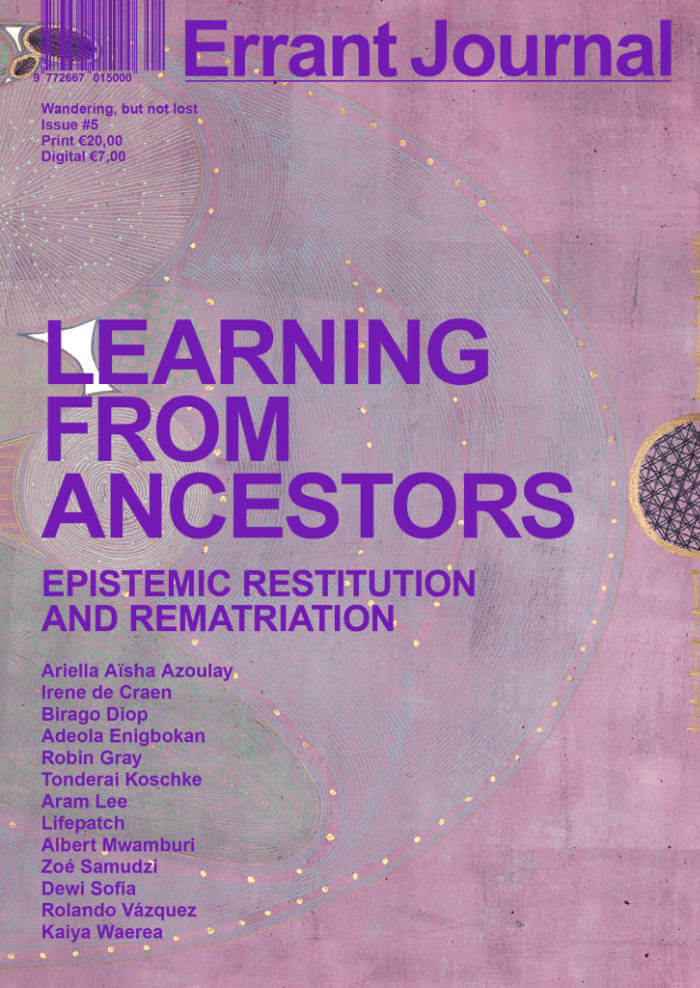
Errant Journal 5: Learning From Ancestors. Epistemic Restitution and Rematriation
Starting from the position that the return of all colonially looted, pillaged, and stolen heritage should take place in full and without hesitation, Errant Journal No. 5 ‘Learning from Ancestors’ wishes to go beyond the question of ‘giving back’, and ask what is given back by whom and to whom, where, and how? In this now seemingly omnipresent discussion, who is speaking, and which voices are being listened to? To do this, as is reflected in the title of this issue, Errant proposes a shift in perspective away from dominant (Western) epistemic authorities to consider other ways of sensing and experiencing the world and let this guide us in the questions we have. This necessarily means that this issue is not just about objects and their return, not just about physical ‘things’ that can change hands and location. It is also an issue about repair, without which restitution could be meaningless.
Contributors: Ariella Aïsha Azoulay, Irene de Craen, Birago Diop, Adeola Enigbokan, Robin Gray, Tonderai Koschke, Aram Lee, Lifepatch, Albert Mwamburi, Zoé Samudzi, Dewi Sofia, Rolando Vázquez, Kaiya Waerea
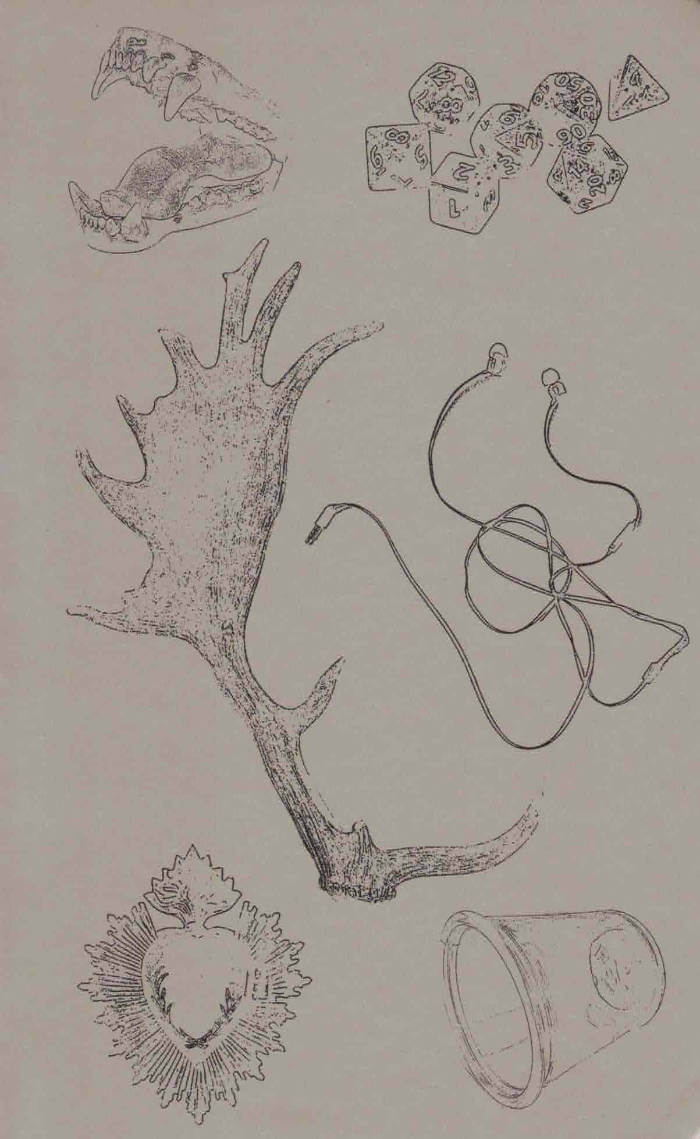
to enter the forest
to enter the forest is an invitation to suspend the acquired systems of knowledge, to look for other ways of “world making.” The book includes a revised and extended version of to err together with the unpublished correspondances.
to err gathers walking exercises and notes, created as instruments for choreographic composition, but practicable by anyone, to put one’s perspective about self and what is other to self, as well as the relations between things, even beyond the human, into question.
correspondances is an ensemble of writing exercises through which to investigate the system of consciousness around verbal language, asking ourselves what words mean from a slightly shifted perspective.
The publication is coproduced by a.pass, nadine, Buda Art Centre, Indisciplinarte, Flanders State of the Art.
lucia palladino is a transdisciplinary artist and researcher in the fields of performance, choreography, and dance. Her practices consist in the elaboration of forms of resistance to notions of identity and ownership naturalized by history and by culture, that define our knowledge and expectations and that need to be undone in order to make space for meeting.

Mural
Last poems from the national poet of Palestine.
Mural is the testimony of one of the most important and powerful poets of our age.
Mahmoud Darwish was the unofficial laureate of Palestine. One of the greatest poets of the last half-century, his work evokes the loss of his homeland and is suffused with the pain of dispossession and exile. Here, his close friends John Berger and Rema Hammami present a beautiful new translation of two of Darwish’s later works: his long masterpiece Mural, a contemplation of his life and work written following life-threatening surgery, and his last poem, The Dice Player, which Darwish read in Ramallah a month before his death.
Illustrated with original drawings by John Berger.
Introduction by John Berger
Translated by John Berger and Rema Hammami

Settler Colonialism An Introduction
From the Palestinian struggle against Israeli Apartheid, to First Nations' mass campaigns against pipeline construction in North America, Indigenous peoples are at the forefront of some of the crucial struggles of our age. Rich with their unique histories, characteristics, and social relations, they are connected by the shared enemy they face: settler colonialism.
In this introduction, Sai Englert highlights the ways in which it has, and continues to shape our global economic and political order. From the rapacious accumulation of resources, land, and labour, through Indigenous dispossession and genocide, to the development of racism as a form of social control, settler colonialism is deeply connected to many of the social ills we continue to face today.
To understand settler colonialism as an ongoing process, is therefore also to start engaging with contemporary social movements and solidarity campaigns differently. It is to start seeing how distinct struggles for justice and liberation are intertwined.
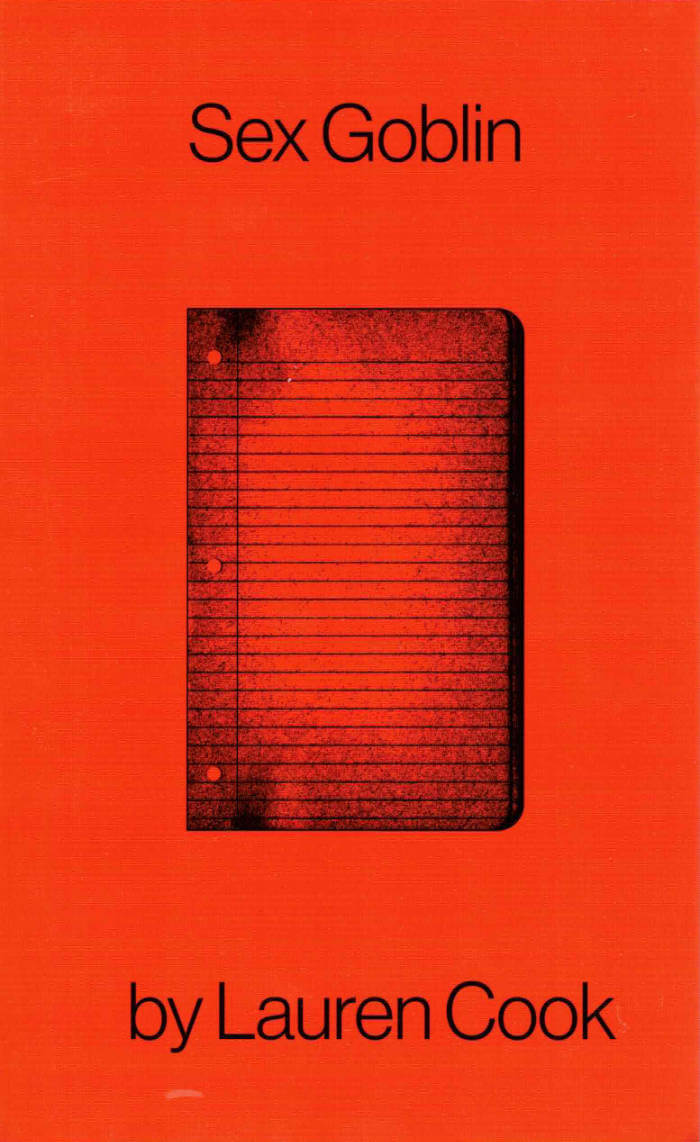
Sex Goblin
A weird, wild ride across non-narrative vignettes and dryly funny aphorisms exploring the shared intensity of violence and the erotic.
As if hauled up squirming from the bowels of the internet, Sex Goblin metabolizes sex writing, popular culture, and autofiction to present the real and the imagined as equally surreal possibilities. In the narrator’s childlike voice, all things become both mundane and strange—a child and their dog fused after a car accident, moments of tenderness amidst frat hazing, witches, and hiking accidents. At turns charming and bizarre, Cook’s work channels sexual violence through the lens of the absurd to alchemize shame and abuse into something that registers differently than trauma. Sex Goblin is a barely factual but deeply felt field guide to relationships and relatability.
Lauren Cook is a transsexual naturalist and the author of I Love Shopping (Glo Worm Press, 2019). He is from upstate New York.

If You're a Girl: Selected Stories 1985–2023
The trailblazing book that influenced a generation of writers, and proves that mature reflection needn't be lacking in attitude.
In the beginning when everything was very sexual we talked about our fantasies. She thought about having a guy for some of it. She thought about having a gun. I had gone through a lot to get away from guys so I admit that the thought of going back to them, even for a little adventure, was surprising and disconcerting …
Ann Rower's first book, If You're a Girl, published by Semiotext(e)'s Native Agents series in 1991 in tandem with Cookie Mueller's Walking Through Clear Water in a Pool Painted Black, cemented her reputation as the Eve Babitz of lower Manhattan.
Rower was fifty-three years old at the time. Her stories—urtexts of female autofiction—had long been circulating within the poetry and postpunk music scenes. They were unlike anyone else's: disarming, embarrassing, psuedoconfessional tales of everyday life dizzily told and laced with dry humor. In If You're a Girl, she recounts her adventures as Timothy Leary's babysitter, her artistic romance with actor Ron Vawter, and her attempts to evade a schizophrenic stalker.
Rower went on to publish two novels: Armed Response (1995) and Lee & Elaine (2002). After the 2002 suicide of her partner, the writer Heather Lewis, Rower stopped writing for almost two decades. And then she picked up where If You're a Girl left off. No longer a girl, she produced dozens of stories from her life in New York as an octogenarian.
This new, expanded edition includes most of the original book, together with selections from both her novels and her recent writings. If You're a Girl is a trailblazing book that manifests Rower's influence on a generation of writers, and proves that mature reflection needn't be lacking in attitude.
Ann Rower is the author of If You're A Girl, Armed Response, and Lee & Elaine. She received a PhD from Columbia University in sixteenth-century English literature in 1974, and has collaborated with the Wooster Group as a writer. Rower taught writing in New York at the School for Visual Arts between 1974 and 2019.
Introduction by Sheila Heti.

Little Sisters and Other Stories
Selected short stories by one of the most acclaimed voices in post-war US American science fiction.
This volume presents a selection of short fiction by Vonda Neel McIntyre (1948–2019), one of the most acclaimed writers of post-war US American science fiction, and the winner of multiple awards for both novels and short fiction.
These stories, which span the whole of McIntyre's career, show the broad range of her interests and her voice, taking us from bleak dystopian worlds on the verge of environmental collapse to baroque intergalactic civilizations populated by genetically modified humans, from cries for freedom to sharp-eyed satire to meditations on aging. Throughout run her distinctive themes of gender and power dynamics, human and species diversity, and a pragmatic utopianism that emphasises our mutual dependency.
The stories included in the volume are: "Breaking Point," "Thanatos," "Shadows, Moving," "Elfleda," "A Story for Eilonwy," "Malheur Maar," "The Adventure of the Field Theorems," "Little Faces", "Little Sisters," and "XYY" (previously unpublished).
Vonda Neel McIntyre (1948–2019) was one of the most acclaimed voices in US American science fiction from the 1960s onwards. A novelist, short story writer, essayist, and critic, she won her first Hugo Award in 1973 for her novella "Of Mist, and Grass, and Sand." This formed part of her ground-breaking feminist novel Dreamsnake (1978), which won both the Hugo and the Nebula Award. A later novel, The Moon and the Sun, won the Nebula in 1997. McIntyre contributed extensively to debates within the US sf community over the role of women in science fiction, and was instrumental in founding the Clarion West Writers Workshop for novice sf writers. A final novel, The Curve of the World, was completed shortly before her death.

Merchant
A post-apocalyptic retelling of William Shakespeare's The Merchant of Venice.
Who will survive when the world is destroyed? Can stories from the distant past teach us how to change a dismal present? Merchant shifts perspective between three survivors of a flooded world as they try to navigate the threat of mass starvation; Jessica, a patrilineal Jew from Venice (named after the Italian city but located on the mountain K2) who has memorized the complete works of Shakespeare; Cem, an orphan of Venice; and Shinobu, an advisor to the empress Ama in Fuji. Ama has been gifting edible algae blocks to nations worldwide, but Jessica's arrival in Fuji to beg for more food for Venice upsets the delicate international balance Shinobu has been maintaining. As a series of buried secrets and miscommunications carry consequences of potential global destruction, everyone must determine what they are willing to do to survive in a hopeless world.
Alexandra Grunberg attended New York University's Tisch School of the Arts earning a BFA in Theatre. She earned her MLitt and DFA in Creative Writing at The University of Glasgow. Grunberg presented her research at various academic conferences in the UK, including “Once and Future Fantasies” at the University of Glasgow, “CRSF 2021 10th Anniversary Conference—Speculative Futures & Survival” by the University of Liverpool, “Beast Modernisms Conference 2019” at The University of Glasgow, “Creative Writing: Processes, Theory, and Influences” at The University of Edinburgh, and “The Literary Self: From Antiquity to the Digital Age” at The University of Edinburgh.

Extraterrestrial Languages (paperback)
If we send a message into space, will extraterrestrial beings receive it? Will they understand?
The endlessly fascinating question of whether we are alone in the universe has always been accompanied by another, more complicated one: if there is extraterrestrial life, how would we communicate with it? In this book, Daniel Oberhaus leads readers on a quest for extraterrestrial communication. Exploring Earthlings' various attempts to reach out to non-Earthlings over the centuries, he poses some not entirely answerable questions: If we send a message into space, will extraterrestrial beings receive it? Will they understand? What languages will they (and we) speak? Is there not only a universal grammar (as Noam Chomsky has posited), but also a grammar of the universe?
Oberhaus describes, among other things, a late-nineteenth-century idea to communicate with Martians via Morse code and mirrors; the emergence in the twentieth century of SETI (the search for extraterrestrial intelligence), CETI (communication with extraterrestrial intelligence), and finally METI (messaging extraterrestrial intelligence); the one-way space voyage of Ella, an artificial intelligence agent that can play cards, tell fortunes, and recite poetry; and the launching of a theremin concert for aliens. He considers media used in attempts at extraterrestrial communication, from microwave systems to plaques on spacecrafts to formal logic, and discusses attempts to formulate a language for our message, including the Astraglossa and two generations of Lincos (lingua cosmica).
The chosen medium for interstellar communication reveals much about the technological sophistication of the civilization that sends it, Oberhaus observes, but even more interesting is the information embedded in the message itself. In Extraterrestrial Languages, he considers how philosophy, linguistics, mathematics, science, and art have informed the design or limited the effectiveness of our interstellar messaging.

Media Burn—Ant Farm and the Making of an Image
Ant Farm, the conceptual architectural practice turned art collaborative, is known for such distinctive works as House of the Century (1971–73), Cadillac Ranch (1974), and The Eternal Frame (1975).
Of equal notoriety is Media Burn, Ant Farm’s legendary 1975 performance, in which a radically customized Cadillac was driven through a wall of burning television sets. Media Burn: Ant Farm and the Making of an Image is a vibrant assessment of the complex set of cultural references and art-making strategies informing this collision of twentieth-century icons.
Author Steve Seid (Berkeley Art Museum and Pacific Film Archive) probes the little-known critical backstory of this bold performance (and resulting video work) and its irreverent effort to mount a subversive critique of media hegemony while reimagining the core meaning of performance itself.
Media Burn: Ant Farm and the Making of an Image examines car culture, image proliferation, and radical architectural practice, and offers a close read of Media Burn’s numerous texts, speeches, ephemera, and artifacts.

… Through Practices
The books included in the series ‘Choreography as Conditioning’ are rooted in a cycle of work sessions entitled CASC at KASK, in which students work together with invited guests. They explore the notions of choreography, understood as ways of organizing subjects in their surroundings, and conditioning in both art-making and society-making. Where, how, and by whom are things organized and what kind of landscapes of experience are made (im)possible by the practices we enact and encounter?
‘… Through Practices’ is written by artist researchers who have been involved in a three-day public symposium with the same title, exploring ecologies of attention, awareness, senses of participation, and agencies of practice. It presents resonances and sedimentations of individual, shared, and collective practices, mirroring different forms of participating and responding—diverse in/capacities, im/possibilities, and dis/interests as they appear in and through experience.

Choreography as Self-Conditioning — A Written Exhibition
he books included in the series ‘Choreography as Conditioning’ are rooted in a cycle of work sessions entitled CASC at KASK, in which students work together with invited guests. They explore the notions of choreography, understood as ways of organizing subjects in their surroundings, and conditioning in both art-making and society-making. Where, how, and by whom are things organized and what kind of landscapes of experience are made (im)possible by the practices we enact and encounter?
The fourth book, ‘Choreography as Self-Conditioning’, presents a ‘written exhibition’. It consists of re-scripted scores originally developed for the architectural space and the live audience of ‘House of Ear’, an immersive and intro-active sound parcours conceived and curated by David Helbich and Joris Blanckaert. These scores are DIY versions of the original works that invite readers to re-activate and engage with the thinking processes they stem from.

KAMERA CAHIER N° 8
A special edition issue curated, designed and published by AVARIE, Paris and Labor Neunzehn, Berlin. It accompanies KAMERA SERIES, while it is an independent and valuable object to collect.
The central idea that informs and directs the booklets’ montage is the interplay between the concepts of addition and subtraction. This is achieved by unveiling a missing image in the screening or an unreleased second from an artist's film, expanded to 24 pages. Additionally, each booklet contains a piece directly removed from the show.
The editing establishes a dialogue between film frames and performed writings derived from texts, scripts, storyboards, and notes. The KAMERA exhibition is consequently extended into a physical space—the book—allowing for its widespread dissemination, complementing and contrasting with its potential online occurrence.
KAMERA SERIES is a screening program of experimental films, video art works and printed matter taking place in a former GDR building in Berlin.

KAMERA CAHIER N° 5
Louise Crawford, Stéphan Guéneau
A special edition issue curated, designed and published by AVARIE, Paris and Labor Neunzehn, Berlin. It accompanies KAMERA SERIES, while it is an independent and valuable object to collect.
The central idea that informs and directs the booklets’ montage is the interplay between the concepts of addition and subtraction. This is achieved by unveiling a missing image in the screening or an unreleased second from an artist's film, expanded to 24 pages. Additionally, each booklet contains a piece directly removed from the show.
The editing establishes a dialogue between film frames and performed writings derived from texts, scripts, storyboards, and notes. The KAMERA exhibition is consequently extended into a physical space—the book—allowing for its widespread dissemination, complementing and contrasting with its potential online occurrence.
KAMERA SERIES is a screening program of experimental films, video art works and printed matter taking place in a former GDR building in Berlin.
75 numbered copies +
screenprinted newsprints’ fragment
24 pages / color plates
book size 21 x 14,5 cm
papers fedrigoni sirio rough pearl 210 and arena white rough 120

KAMERA CAHIER N° 2
A special edition issue curated, designed and published by AVARIE, Paris and Labor Neunzehn, Berlin. It accompanies KAMERA SERIES, while it is an independent and valuable object to collect.
The central idea that informs and directs the booklets’ montage is the interplay between the concepts of addition and subtraction. This is achieved by unveiling a missing image in the screening or an unreleased second from an artist's film, expanded to 24 pages. Additionally, each booklet contains a piece directly removed from the show.
The editing establishes a dialogue between film frames and performed writings derived from texts, scripts, storyboards, and notes. The KAMERA exhibition is consequently extended into a physical space—the book—allowing for its widespread dissemination, complementing and contrasting with its potential online occurrence.
KAMERA SERIES is a screening program of experimental films, video art works and printed matter taking place in a former GDR building in Berlin.
75 numbered copies + 16 mm film print
24 pages / color plates
book size 21 x 14,5 cm
papers fedrigoni sirio rough pearl 210 and arena white rough 120
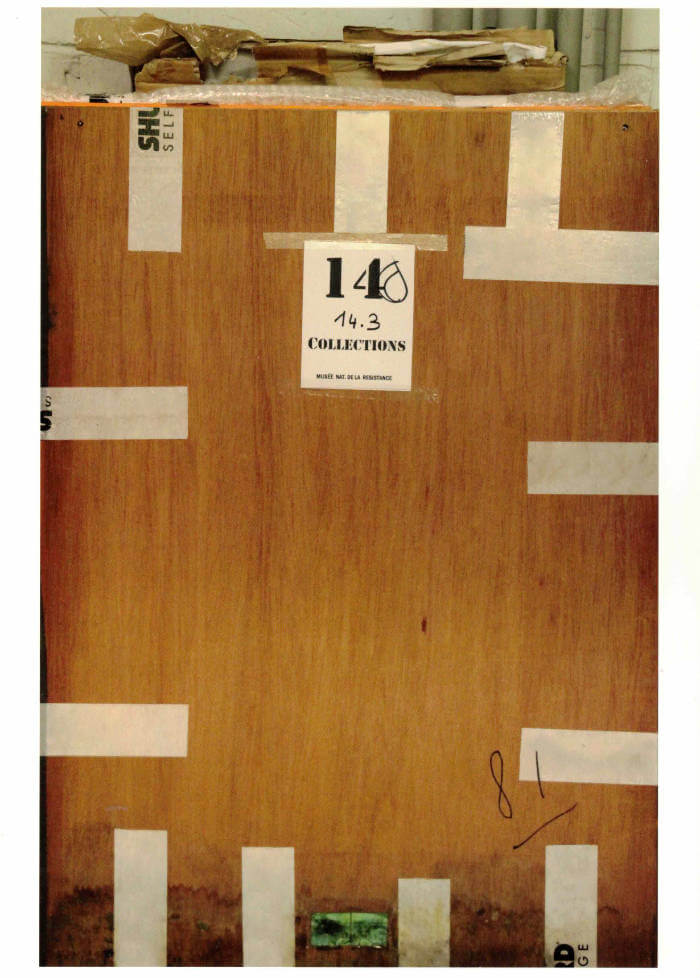
À Reclasser
This publication shows the waiting archive of the Museum of Resistance. The Brussels Museum of Resistance is undergoing renovation. Hidden in the basements of the civil affairs department, the stacked archive awaits a new home. Boxes filled with recognition files, photo albums, exhibition panels, books, flags, furniture, and other scenographic materials are scattered throughout the entire floor plan. The recently appointed archivist Samuel and historian Agnes are sorting through the archive pieces and are striving to ensure a future.

ZILCH
In banana boxes, Maxime Le Bon collects and stores a lot of documents in a jumble. Most of them are printed, cut out from newspapers, magazines, old publications, erratas and other fragments of texts. Added to this are drawings that he improvises - some of them torn or stained that he don't want to display or throw away. This collection of heterogeneous items is then being rearranged and slipped into plastic pockets where he stores them. Unstable and in constant change, this improbable archive grows with the years. It sedimented layers of experiences and constitutes this heterogeneous deposit from which can emerge all sorts of fragmentary narratives and accidental arrangements. The publication ZILCH brings together a selection of images from this extensive archive.
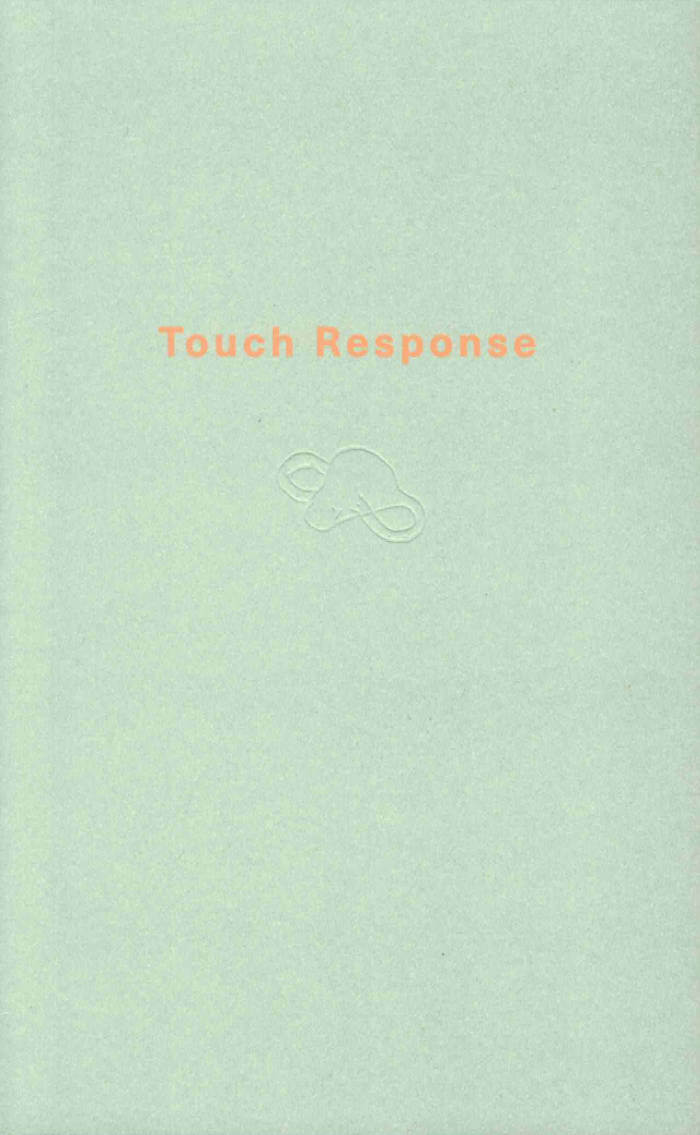
Touch Response
Touch Response is about lacking language and how to (not) interpret images. This is a book on vulnerability, as a description, prescription or side effect. It is made in a difficult period of fatigue and pain, mainly in the sofa in my living room, as a dialogue with myself and other invisible forces.
Drawings by Lore Smolders - visual artist
Interview with Birds WG - healer, writer, performance artist
Text editing by Isolde Vanhee and Joan Somers Donnelly

Who can afford to be critical?
‘Critical Designers’ produced by an increasing number of design schools are prompted to address social, political and environmental issues through their practices. Yet, who can afford to continue such effort after graduation?
In a dynamic style holding multiple voices, Who Can Afford To Be Critical? discusses the limits that affordability, class and labour impose upon the educational promise of holding a ‘critical’ practice. Why do we tend to ignore the material and socioeconomic constraints that bind us as designers, claiming instead that we can be powerful agents of change? In fact, where does our agency lie?
Instead of focusing on the dream of ethical work under capitalism, could we, instead, focus first on designers’ own working conditions, targeting them as one immediate site for collective action? And can we engage politically with the world not necessarily as designers, but as workers, as activists, as citizens?

What is post-branding?
Post-Branding empowers better design of public communication for civic and activist groups by replacing corporate branding’s predatory principles with a new set of strategies embedded in a new culture of craft. A new way of being and knowing, for a new way of relating with the world.
Brands aren’t just intruding on culture, they are our culture. They are the sponsored mechanisms for constructing and manipulating meaning and human identity. But should we cede such a fundamental human need to the market? If not, why not, and is there an alternative?
What is Post Branding? is a work of ‘practical theory’. It is a compact ‘pocket-book’ format publication composed of four main sections. The first, ‘DIS-BRANDED’, is a text of 20 short page-long chapters exposing the ideological underbelly and real-world impact of branding. The second, ‘MIXED MESSAGES’, is a provocative visual essay illuminating the texts’ main themes. The third, ‘MANUAL’, presents a framework for a critical alternative to corporate branding, humorously appropriating found instructional diagrams as a brand manual satire. This section also includes examples of completed contemporary projects that have implemented post-branding principles. The book concludes with ‘CONTEXT’, featuring a conversation with cultural theorist Brian Holmes and an argument with design historian Steven Heller.
Part design experiment, part critical theory, and part how-to-manual, What is Post-Branding? introduces a creative counter to branding’s neoliberal orthodoxy.
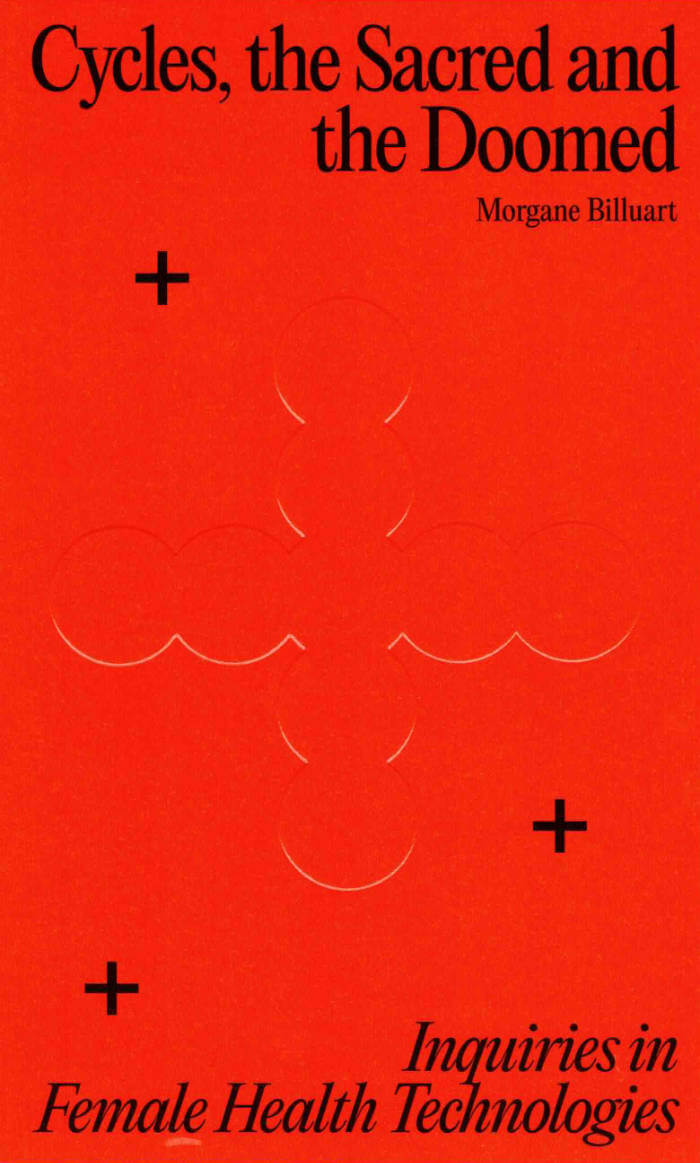
Cycles, the Sacred and the Doomed
In a world propelled by swift technological progress and perpetual obsolescence, women frequently find themselves adapting and altering their daily experiences in order to remain functional. In the 21st century, as technology purports to comprehensively assess and address women’s conditions and physical discomfort, Cycles, the Sacred and the Doomed delves deeply into the realm of female health technologies, revealing a space where science, holistic methods, and mythology converge. This book challenges the idea of combining ancient wisdom with modern innovation and takes readers on a multidisciplinary journey to explore the intricacies of female’s health.

Design Against Design
Design Against Design argues for the urgent necessity of critical engagement and political resistance through graphic practice. It draws on insights from the practice of LOKI, a small graphic design studio committed to working with social movements towards radical political change. With conversational interviews, personal and critical essays, and a wide-ranging selection of graphic works, this book unravels the real-world relationships, motivations and contradictions involved in a socially engaged design practice.
Both a passionate indictment of the discipline of graphic design, and a utopian love letter to its radical potential, Kevin Yuen Kit Lo’s collection of almost confessional, candid essays challenge the status quo of design writing. Design Against Design demands that we think more intimately about the politics of visual culture under contemporary capitalism and, importantly, how we can act against it.
Design Against Design is organized around four key themes: Critique presents a political-economic analysis of graphic design in relationship to capitalism and considers practical ways to resist it. Practice looks critically at how designers work towards (and sometimes against) social change within both a professional studio context and alongside social movements. Materiality focuses on the craft of graphic design; on language and typography, legibility, and illegibility, on the acts of speaking and making. Autonomy considers the emotional and relational aspects of graphic design, understanding that interdependence is intricately bound to any possibility for self-determination within and beyond design.
Featuring interviews with Philippe and Nancy Vermes, Sandy Kaltenborn, Kaie Kellough, Chadi Marouf and Sabine Friesinger, Sarah Auches, and Jenn Clamen.

échos
ÉCHOS is an intuitive investigation, redacted by using a compact digital camera. Those photos date from 2014 to 2018 and were shot in and around Brussels (up to 1350 km away), at any time of day or night, following a simple desire to look at things intensely and interpret signs playfully.
200 numbered copies
212 pages color photography printed in BE
With an introducing text by Constantin Carsoux